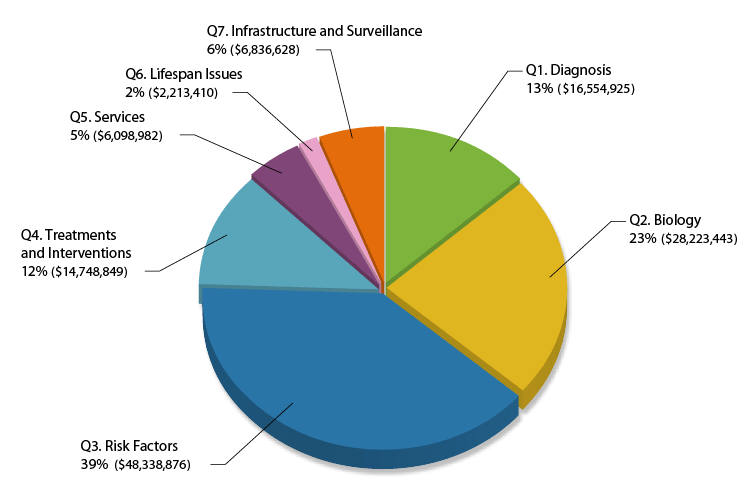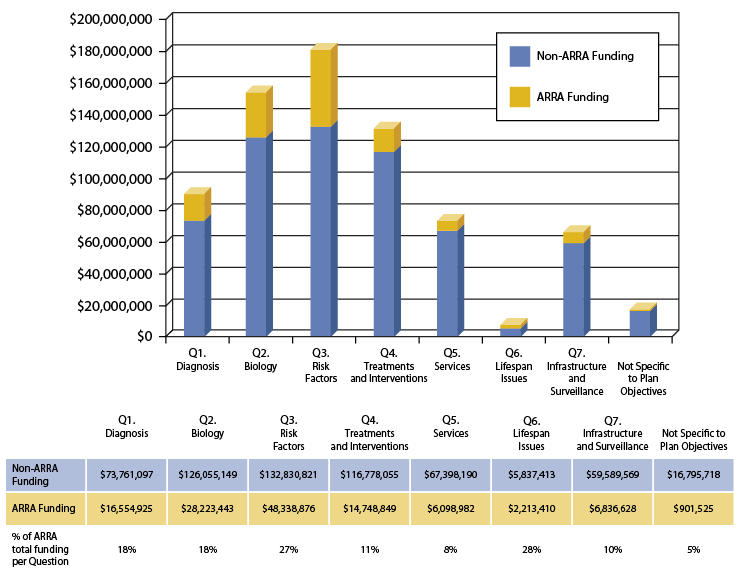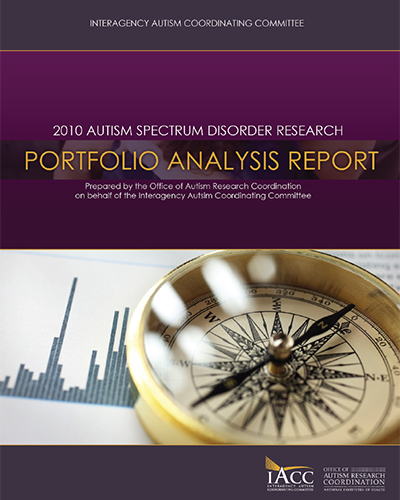Portfolio Analysis Report
IACC Autism Spectrum Disorder Research
2010
The American Recovery and Reinvestment Act (ARRA) was enacted by Congress in February 2009 with the objective of stimulating the economy, creating and preserving jobs, and investing in long-term growth. ARRA funds received by Federal agencies were awarded to grantees over a two-year period from 2009 to 2010. Thus, this 2010 Portfolio Analysis includes data from 2010 ARRA grants as well as a comprehensive snapshot of all ARRA funds that supported autism research in 2009 and 2010. Among the Federal agencies that fund autism research projects, as described in this report, the National Institutes of Health (NIH), the National Science Foundation (NSF), and the Agency for Healthcare Research and Quality (AHRQ) reported use of ARRA funds to support autism research projects. The total funding and number of projects from each of these agencies can be found in Table 3 below. Please note that 2009 data for AHRQ and NSF were not captured in the 2009 Portfolio Analysis; thus, only 2010 ARRA funding information was available for these funders.
2009 and 2010 ARRA Funding Allocated to Autism Research
| Federal Agency | Number of projects | ARRA funding | Percent of total ARRA funding |
|---|---|---|---|
Federal AgencyNational Institutes of Health | Number of projects256 |
ARRA funding$121,504,953 |
Percent of total ARRA funding98% |
Federal AgencyNational Science Foundation | Number of projects8 |
ARRA funding$1,361,172 |
Percent of total ARRA funding1% |
Federal AgencyAgency for Healthcare Research and Quality | Number of projects2 |
ARRA fundingD$1,050,513 |
Percent of total ARRA funding1% |
Table 3. Three funders contributed to the total 2009 and 2010 ARRA funding of autism research ($123,916,638). The NIH had the highest funding amount (98%; $64 million in 2009 and $58 million in 2010), and NSF and AHRQ each contributed about $1 million (1%). Data for NSF and AHRQ were only available for 2010, and funding for NSF and AHRQ are estimated amounts.
In total, ARRA funds ($123,916,638 million) comprised 17% of total ASD research funding across all participating Federal agencies and private organizations in 2009 and 2010 (Figure 11). This includes $63,968,992 awarded by NIH in 2009 (27% of all ASD research in 2009) and $59,947,646 in ARRA grants awarded by NIH, AHRQ, and NSF for 2010 (15% of all ASD research in 2010). Over the two year time period, Federal agencies distributed nearly $572 million for autism research, and 22% of those funds came from ARRA (Figure 12).
Impact of ARRA on Total ASD Research Funding in 2009 & 2010
(Total funding = $722,962,650)

Figure 11. ARRA funding accounted for 17% ($123,916,638) of autism research funding in 2009 and 2010. The funding total of nearly $723 million represents support from Federal agencies and private organizations as reported in the 2009 and 2010 Portfolio Analyses.
Impact of ARRA on Federal ASD Research Funding in 2009 & 2010
(Total Federal funding = $571,868,237)

Figure 12 Seventy-eight percent of the $571,868,237 distributed for ASD research by the Federal government in 2009 and 2010 was provided from non- ARRA funds, while the remaining 22% of Federal funding was from ARRA.
The NIH received $8.2 billion total in ARRA funds to help stimulate the U.S. economy through support and advancement of biomedical research. The funds were used to initiate original research projects as well as to expand and enhance existing programs. Because autism was identified as a high priority area for research and the IACC Strategic Plan was in place at the time of ARRA's enactment, several NIH initiatives were developed to invest ARRA funds in this research. (A list of NIH ARRA initiatives that funded autism research can be found in Appendix C.) In 2009, nearly $64 million in NIH ARRA funds were used to jumpstart the implementation of priorities described in the newly released 2009 IACC Strategic Plan for Autism Spectrum Disorder Research, supporting 141 new autism research projects. In 2010, NIH used $58 million in ARRA funds to sponsor 115 autism research projects. Many of the NIH-ARRA funded projects directly aligned with IACC Strategic Plan objectives, including research to identify biomarkers for early diagnosis, develop rapid screening instruments, identify subtypes of autism, explore underlying environmental and genetic risk factors, deliver behavioral therapy via telehealth technology, assist young adults with transition issues including employment, and understand autism in adults.
While the NIH awarded the largest portion of ARRA funding designated for autism research, ARRA projects supported by AHRQ and NSF also contributed significantly to the field. The IACC 2011 Strategic Plan for ASD Research identified comparative effectiveness research as a gap area, and AHRQ used ARRA funds to conduct comparative effectiveness research on treatments for ASD in adolescents and young adults. They also used ARRA funds to disseminate the best practices in autism treatments so that individuals, parents, and practitioners can make informed decisions. NSF used ARRA funds for eight projects, primarily studying the underlying biology of autism, particularly in the areas of speech, abnormal neural connectivity, and face recognition. They also supported projects to develop new technologies to recognize differences in the expression of affect (feeling and emotion) and to develop new measures of sensory motor function that could eventually be used for diagnosis of ASD in infants.
Impact of 2009-2010 ARRA Funding on IACC Strategic Plan Implementation
ARRA funding accounted for 17% of total ASD research funding in 2009 and 2010 (Figure 11), and Figure 13 conveys the distribution of all ARRA funding across the questions of the IACC Strategic Plan.
2009 & 2010 ARRA ASD Research Funding by IACC Strategic Plan Question
(Total ARRA funding = $123,916,638)

Figure 13. Topic areas are defined by each question in the IACC Strategic Plan. The largest proportion of ARRA ASD research funding (39%) was devoted to risk factors for ASD (Question 3); 23% of the research addressed the underlying biology of ASD (Question 2); 13% related to diagnosis (Question 1); 12% related to interventions and treatments (Question 4); 6% related to surveillance and infrastructure (Question 7); and 5% related to services (Question 5). Research on lifespan issues (Question 6) received just 2% of the ARRA ASD research funding. Projects that were not specific to Strategic Plan questions accounted for less than one percent of ARRA-funded research in autism ($901,525; not shown on graph).
Research support received from ARRA focused largely on the identification of environmental and genetic risk factors for ASD (Question 3, 39%). Projects related to the underlying biology of ASD, including studies of genetically related disorders and co-occurring conditions, also received considerable support (Question 2, 23%). Diagnosis of ASD and treatments and interventions were also supported with ARRA funds (Question 1, 13% and Question 4, 12%, respectively). Research associated with services and lifespan issues received the least ARRA funding over the two year time period (5% and 2%, respectively), although ARRA investments in services research increased by one-third between 2009 and 2010 (from 4% to 6%), and lifespan research more than doubled (from 1% to almost 3%).
ARRA funds contributed significantly to several areas of the IACC Strategic Plan in 2009 and 2010. More than one-fourth of all funding for Question 6 (Lifespan Issues) and Question 3 (Risk Factors) came from ARRA (Figure 14). For Questions 1 and 2 (Diagnosis and Biology, respectively), ARRA supported more than 18% of the research. About a tenth of the research in the areas of treatments (Question 4) and infrastructure (Question 7) received ARRA funds, along with 8% of services research (Question 5).
Impact of 2009 & 2010 ARRA Funding on ASD Research:
Alignment with the IACC Strategic Plan

Figure 14. 2009 and 2010 ASD funding for each of the 2011 IACC Strategic Plan questions based on traditional funding sources or ARRA funding. Traditional funding is designated in blue, while ARRA funding is designated in yellow. ARRA funds comprised 27% of all funding for Questions 3 and 6, 18% of all funding for Questions 1 and 2, 11% of all funding for Question 4, 10% of all funding for Question 7, 8% of all funding for Question 5, and 5% of the funding for projects that were not specific to any of the Strategic Plan questions.
While research funding for autism was already increasing prior to 2009, the influx of ARRA funds allowed additional funding to be applied to gap areas in research and stimulated even greater advances in the field. Although ARRA provided the opportunity to jumpstart new areas of research, budget uncertainty in the future has raised concern about the sustainability of progress in the years to come.




